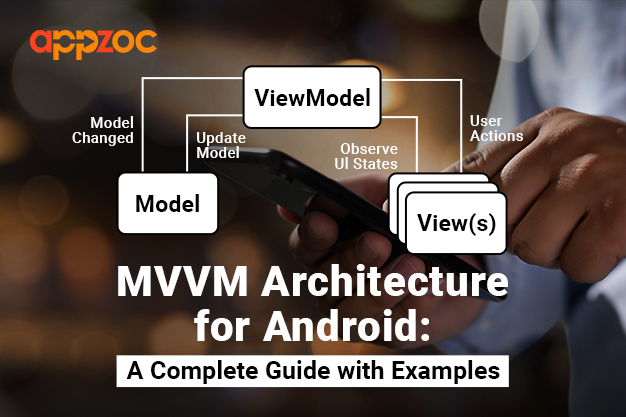
Flutter
Make the most of this cutting-edge technology by developing apps quickly! Our Flutter solutions have amazing features that can be used to create sleek, high-performance apps that can scale seamlessly across platforms.

The Android developer world is large and ever-changing. With each passing day, new methodologies and architectures emerge, aiming to simplify the development process and enhance app performance. One such architecture that has gained immense popularity in recent years is the MVVM (Model-View-ViewModel) architecture. In this comprehensive guide, we’ll delve deep into MVVM, its benefits, and provide practical examples to help you grasp its concepts. Moreover, we’ll see how leading development firms like Appzoc Technologies are leveraging MVVM to create stellar Android applications.
MVVM stands for Model-View-ViewModel. It’s an architectural pattern designed to segregate the development of the graphical user interface from the business logic. Here’s a breakdown of its components:
Model: Represents the application’s data and business logic. It is in charge of retrieving, storing, and processing data.
View: Represents the UI of the application. It displays data from the ViewModel to the user and sends user commands to the ViewModel.
ViewModel: Serves as a connector between the Model and the View. It holds the presentational logic and ensures that the View remains as simple as possible.
Separation of Concerns: MVVM promotes a clear separation between the application’s UI and its business logic. As a result, the code is more modular and manageable.
Testability: Due to the decoupling of components, testing becomes more straightforward. Developers can test each component independently, ensuring robust application performance.
Data Binding: MVVM supports two-way data binding between the View and ViewModel. This means any changes in the ViewModel are automatically reflected in the View and vice versa.
Improved Scalability: As the application grows, MVVM makes it easier to scale without compromising on performance or readability.
MVVM in Action: Practical Examples
Scenario: Developing a login screen for an Android app.
Model: This would contain the logic to validate the user credentials, perhaps by checking against a database or an API.
View: This would be the actual login screen UI where users input their credentials.
ViewModel: Upon the user hitting the ‘Login’ button, the ViewModel takes the input data, communicates with the Model to validate the credentials, and then updates the View based on the validation result.
This clear distinction ensures that if, for instance, the validation logic in the Model changes, the View remains unaffected. Similarly, if the UI design changes, the Model doesn’t need any modifications.
Appzoc Technologies, a prominent player in the Android development arena, has been a strong advocate for the MVVM architecture. Recognizing the myriad of benefits it offers, Appzoc Technologies has seamlessly integrated MVVM into its development process. Their portfolio boasts numerous Android applications built on MVVM, reflecting the architecture’s efficiency and robustness. By adopting MVVM, Appzoc ensures that their applications are not only high-performing but also scalable and maintainable.
Also Read:Reducing Your Android App Size: Optimize Images, Code & Resources
MVVM architecture has undeniably set a new standard in Android development. Its emphasis on separation of concerns, coupled with enhanced testability and scalability, makes it a preferred choice for many developers. Practical examples further elucidate its effectiveness in handling real-world scenarios.
Companies like Appzoc Technologies have already recognized and harnessed the power of MVVM, delivering top-notch Android applications to their clientele. If you’re venturing into Android development or looking to refine your existing skills, understanding and implementing MVVM is a step in the right direction. It’s not just an architectural pattern; it’s a blueprint for building efficient, scalable, and maintainable Android applications.